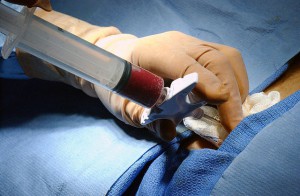
A patient’s bone marrow is extracted for a hematopoietic stem cell transplant, or HSCT. Once just a last-resort treatment for cancer, HSCTs are now used for a growing list of conditions, including certain metabolic disorders affecting the brain. (US Navy/Wikimedia Commons)
The history of hematopoietic stem cell transplant (HSCT) starts with severe cancers of the blood or immune system, like relapsed leukemias or lymphomas. Today, HSCTs are no longer solely the treatment of last resort for cancer but is used to treat a growing list of pediatric and adult conditions.
Most of these are cancers and blood disorders, but in recent years, a new frontier has opened up for HSCT: treatment of metabolic diseases, in particular, ones that affect the function of the brain.
Two things have driven the expansion of HSCT applications:
- With improvements in medical treatment of cancers, the number of transplants for malignant conditions is going down.
- Improvements in the safety of HSCTs—and in particular, reductions in the toxicity of the conditioning regimens used prior to transplant—have encouraged the use of transplants for non-malignant conditions like bone marrow failure syndromes, sickle cell disease, anemias and genetic immunodeficiencies.
These improvements, along with better understanding of the biology of metabolic disorders, have set the stage for specialists like Christine Duncan, MD, associate clinical director of the Stem Cell Transplant Center at Dana-Farber/Boston Children’s Cancer and Blood Disorders Center. Duncan has, to date, carried out bone marrow transplants in five children with adrenoleukodystrophy (ALD), one with Krabbe disease and one with Hurler syndrome.
While the list of metabolic conditions or inborn errors of metabolism is pretty broad, they all have one thing in common: an inherited or spontaneous mutation that results in the loss of an enzyme that cells need to carry out essential chemical reactions. These disruptions keep different organs and tissues, often including the central nervous system, from functioning properly.
New blood cells = new brain cells
Why would transplanting stem cells be of use here? ALD provides a good example. Children with the condition cannot produce an enzyme called ALDP, which helps break down fatty acids in the brain and the rest of the body.
The cells that normally produce ALDP are derived from hematopoietic stem cells, so receiving healthy stem cells from a bone marrow donor enables patients with ALD to begin producing the missing enzyme. Some of the new stem cells travel to the brain and differentiate into microglial cells, which can supply the enzyme to the brain and spinal cord.
But it takes time. “When a boy with ALD is transplanted, the stem cells engraft in the same time frame as patients transplanted for other conditions,” says Duncan. “The key is to wait for the stem cells to differentiate into microglia in the brain, and to start functioning. It can be as long as nine months before you see an effect, and then the goal is to stop disease progression. We do not expect the transplanted cells to repair damage that occurred before transplant.”
All that time, the disease is progressing. Which is why time is of the essence when considering a transplant for a child with ALD or another metabolic condition.
To identify children with ALD, Krabbe, Hurler and other metabolic conditions earlier in order to keep the option of HSCT on the table, Duncan, neurologist Irina Anselm, MD, and geneticist Edward Neilan, MD, PhD, are building relationships with neurologists and metabolism specialists across Boston Children’s and at Massachusetts General Hospital.
“Most of the patients we see are very sick,” says Anselm, who works in the Neurometabolic Program at Boston Children’s. “These conditions can also be very hard to diagnose and occasionally, by the time a patient comes to us, it’s too late to consider them for transplant. They’ve progressed too far.
“But if a child has siblings and those siblings are not showing signs of disease,” Anselm adds, “we can test them to see if they also have the condition and haven’t yet progressed. If yes, then we can consider whether a transplant may be appropriate.”
More care than cure
Anselm is quick to point out that HSCTs don’t necessarily cure these metabolic conditions but can relieve symptoms if done appropriately.
“Metabolic diseases can present themselves in severe or more mild forms and may not always benefit from a transplant,” she says. “The decision whether to transplant or not depends on many considerations.” Such as how far a child’s disease has progressed, whether the disease will continue to progress without the transplant and whether appropriate enzyme replacement therapy is available. With ALD and Krabbe, for example, enzyme replacement is not currently an option.
Largely because some of the patients are further out from transplant than others, the results of the seven transplants Duncan has carried out have been mixed. “All of the children are alive at various points after transplant, ranging from three years to a few weeks,” she says. “One child has had disease progression, and two children have had stable disease. With the other four, it’s too early after transplant to know about their long-term disease control.”
Anselm says that she’s happy to be working with Duncan’s HSCT team and is confident the risk/benefit ratio for children with metabolic disorders will continue to improve with experience. “We think that as time goes on, and we are able to catch more children early, more of them will go on to undergo transplant.”






